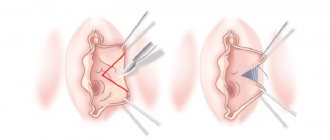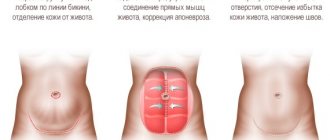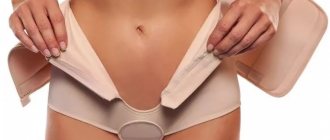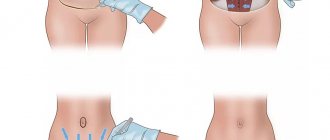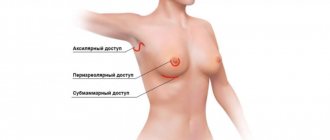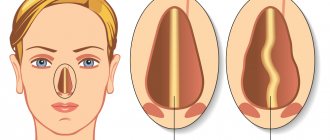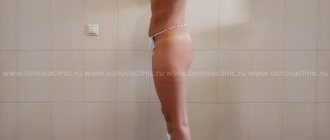Modern plastic surgery offers great opportunities to achieve your aesthetic ideal. If you cannot get a beautiful flat stomach and thin waist through sports and diet, abdominoplasty comes to the rescue. This is a very effective, but also very difficult operation - for both the doctor and the patient.
Rehabilitation after abdominoplasty takes a long time and requires special attention from the patient. At this time, you will have to observe a number of restrictions and care for the injured area. The final result depends not only on the qualifications of the surgeon, but also on the responsibility of the patient. In addition, it is worth preparing in advance for stiffness of movement, swelling and bruising, which always accompany the patient in the postoperative period.
Table of contents
- What is abdominoplasty?
- Technique
- After abdominoplasty
- Abdominoplasty: swelling
- Lingerie after abdominoplasty
- Suture after abdominoplasty
- Recovery after abdominoplasty at home
If previously excess weight and moderate obesity were valued and were a sign of prosperity and good position in society, now the standard of beauty has changed a lot. People, especially women, strive to get rid of unwanted pounds: they go on diets, exercise, and some use more radical methods. One of these is abdominoplasty - abdominoplasty.
General recommendations
This operation is a surgical intervention, and the body requires time to recover. So, immediately after plastic surgery on the anterior abdominal wall, it is quite natural for swelling to appear in this area. Also, you may be bothered by aching pain, which can be reduced by taking pills prescribed by the surgeon (no more than once every four hours). If your body temperature rises above 38°C, you should take antipyretics. Only if you follow all the advice of your plastic doctor, you can expect that you will be satisfied with the result - a new, flat tummy!
Technique
This procedure has several options. Classic abdominoplasty takes from 1 to 5 hours, depending on the complexity. During this time, the patient is made several incisions in the abdomen, and part of the skin is removed. Through the incisions, the surgeon eliminates muscle discrepancies and removes excess fat and skin. Then, if necessary, the navel is secured in a new position, drains are installed so that the remaining contents can flow out, and cosmetic sutures are placed on the incisions. It is also worth noting that the procedure is performed only under general anesthesia.
Absolutely forbidden:
- eat spicy food (until swelling disappears);
- take a bath (at least 2 weeks);
- visit a bathhouse, sauna (8 weeks);
- When taking a shower, direct the stream of water to your stomach;
- lift heavy things (2 months);
- engage in sexual contact (from 2 weeks to 1.5 months);
- perform the exercise with a load on the abdominal muscles (at least 3 months).
Doctors recommend not counting the hours of the postoperative period, but taking advantage of the moment and paying attention to yourself. In the end, at this time you can get enough sleep, get positive emotions and improve your overall health. In this way, you can gradually return to your normal lifestyle, renewed and beautiful.
After abdominoplasty
The first days after surgery are difficult for many. After the operation, the patient is transferred to a ward, where he is placed in a semi-recumbent position and his legs are raised up. This is necessary in order to minimize skin tension in the abdominal area. When the patient finally recovers from anesthesia, he may experience nausea and dizziness, which will subside within a few hours. On the second day after the operation, the patient will be able to stand up, but walking is allowed only in a half-bent position. Also on this day, the first dressing is done and the seam is processed. After abdominoplasty, the abdomen will become hard, and when pressed, there will be discomfort, since the procedure affected muscle tissue that needs time to recover. Severe pain does not occur, because high-tech drugs can reduce any discomfort after surgery to a minimum. Therefore, your doctor may prescribe a course of antibiotics or painkillers. When the patient has more or less recovered (in 4-5 days) and the risk of complications has disappeared, the patient will be discharged home, where he will continue his rehabilitation on his own.
When to see a doctor
Abdominoplasty with suturing of diastasis and rehabilitation after it are considered a difficult period. A number of natural postoperative phenomena will accompany the patient in any case. First of all, this is severe swelling, bruising, discomfort when moving, and an unsightly appearance of the incisions. But these phenomena are considered normal and there is no need to worry about them.
In some cases, phenomena such as:
- palpable tissue hardness upon palpation,
- severe swelling and bloating,
- severe pain,
- temperature increase,
- redness in the area of intervention.
The most common complications are the formation of seroma or hematoma, infection and suture dehiscence. The risks of their occurrence can easily be reduced to zero if you follow the rules during the recovery period and contact a specialist at the slightest suspicion of an unusual course of the situation.
Suture after abdominoplasty
The incision that the surgeon makes during the operation leaves behind a significant scar in the lower abdomen. At first, it needs to be treated daily and the bandages changed. Then the doctor will prescribe special ointments to the patient to speed up healing. Healing a suture is a long process that takes more than one month. A few months after surgery, the suture will become bright red and then gradually begin to become less noticeable. If the scars do not suit the patient, you can always correct the scar.
How does scar formation occur after tummy tuck?
Abdominoplasty is an operation, the positive effect of which is always as noticeable as possible. The result of a tummy tuck brings the highest satisfaction to patients who, after surgery, become the owners of a slender body. But in the case of abdominoplasty, unfortunately, the principle “beauty requires sacrifice” applies. What will a patient who decides to have a tummy tuck have to pay?
A scar after abdominoplasty is an inevitable, but small evil that you have to put up with. How big is it, will the stitch overshadow the effect of the plastic surgery itself, how to speed up the healing process of a postoperative scar?
Will the stitch after abdominoplasty remain for life?
Yes, the surgical incision after any intervention, be it emergency or planned surgery, will remain on the human body forever. Another question is how noticeable and what kind of impact it will be. The size of the incision during abdominoplasty depends on the scale and technique of the operation, and the presence of concomitant pathologies. The more tissue that is removed, the longer the surgical incision and the longer the recovery period.
Types of abdominoplasty and corresponding postoperative scars
The most common tummy tuck option is classic abdominoplasty . The surgeon makes a horizontal incision on the surface of the abdomen - the scar remains at the level of the pubis and protruding pelvic bones. If the skin on your abdomen has significant sagging, the doctor may have to make another incision (circular, U-shaped, or inverted Y) around the belly button to move it to a new location.
If it turns out that the patient is suitable for vertical abdominoplasty , the plastic surgeon makes two incisions. The first is similar to the incision with the classical technique, while the second is performed vertically. It runs along the midline of the abdomen and ends at the sternum. As a rule, the vertical technique is indicated for patients with diastasis and in the presence of significant excess skin after large and sudden weight loss.
Svetlana Pshonkina was recognized as the best plastic surgeon for abdominoplasty as part of the International Diamond Beauty Award
Lateral abdominoplasty . With this technique, three incisions will be made on the abdomen. The first one is horizontal. Two more are on the sides. The last two are needed to eliminate excess fat in the sides and lower back. Through these incisions, the surgeon also performs a lift on the outer thighs.
If we are talking about extended abdominoplasty , then the horizontal classic incision continues in the area of the protruding parts of the iliac bones. In this way, a tightening of the hip area is achieved.
The most traumatic for the patient is a circular tummy tuck . During the operation, the plastic surgeon removes excess skin and fatty tissue not only from the abdomen, but also from the back and outer thighs. It turns out that the incision, and subsequently the scar, runs around the circumference of the body.
As experts admit, miniabdominoplasty is performed quite rarely. The fact is that the indications for this particular operation are limited - the patient must have a slight excess of skin and adipose tissue. In this relatively gentle surgical procedure, a horizontal incision is made in the area above the pubis. The scar remains small - no more than 20 cm.
Svetlana Pshonkina comments
Unfortunately, it is impossible to perform abdominoplasty without a scar. But the presence of a scar should not scare patients away, since it is possible to make the seam as neat and barely noticeable as possible. After today's operations, women do not even need to hide the scar under tattoos. Firstly, we do everything to ensure that the suture line is as low as possible below the line of underwear, secondly, modern suture materials sew the edges of the incision as carefully as possible, and thirdly, methods for forming a postoperative scar and some tricks during the healing period contribute to that the seam heals well and becomes unnoticeable.
Specifics of scar healing after abdominoplasty
A postoperative scar after tummy tuck, in general, goes through the same stages of healing as after any other surgical intervention. But since abdominoplasty is a large and traumatic operation, there are issues that can slow down the recovery process of surgical incisions.
First, to avoid the accumulation of lymph and blood, drains are often installed in wounds. Secondly, due to the specific nature of the operation, the skin and subcutaneous tissue experience significant tension. Sometimes you will notice that the final result - the scar - is slightly wider in the center than at the edges. This is explained precisely by the fact that the tension is always stronger in the middle of the scar.
The location in close proximity of the abdominal muscles also has an impact. Sometimes the slightest contractions of the press can cause the seams to separate.
And in general, with abdominoplasty, this degree of tissue trauma is characterized by an increased risk of possible complications in the form of suture inflammation, necrosis, etc.
Of all of the above, most often problems with recovery occur due to high tissue tension, which will be noticeably felt 1-2 months after surgery. This is not a side effect, but quite typical for tummy tuck. So, under what conditions does scar formation take place?
Svetlana Pshonkina comments
The epithelialization stage is characterized by an increased risk of suture dehiscence. Additional pressure on the vessels produced by the tension of the skin and soft tissues can lead to necrosis and slowdown in the formation of connective tissue cells and fusion of the wound edges. Approximately 2 weeks after the operation, when the so-called “young” scar begins to form, there is a relative restoration of blood flow in the tissues. However, this stage of healing has the risk of forming a hypertrophied scar. This side effect may be caused by permanent tissue tension. To avoid such developments, patients are prescribed physiotherapeutic procedures and ointments designed to prevent the excessive formation of fibroblasts and connective tissue cells.
How to prevent possible seam splitting?
To prevent such complications and speed up the healing of the surgical incision, patients must follow several rules. You will need to follow them for at least a month:
- walk in a bent position
- sleep with your legs crossed
- exclude any physical activity
- Do not lift any weights, even if it is a baby
- follow a diet - do not eat foods that cause bloating and flatulence
- exclude any sports activity
No matter how active an athlete or sleep lover you are, returning to exercise and your favorite sleeping positions is only possible with the permission of your plastic surgeon. No amateur performances!
How does the seam heal after abdominoplasty?
If tissue restoration goes the right way, then the scar will heal according to the following scenario.
- The first month after abdominoplasty . After 4 weeks, the postoperative wound should heal. It will be bright in color, from red to burgundy. The scar will be raised. This appearance will persist, or even worsen, for several months.
- Six months after abdominoplasty . The seam will be just as bright and swollen, but after 6 months positive trends should already appear. By this time, there is a decrease in blood flow and partial destruction of fibrous tissue. As a result of these changes, the scar should acquire a lighter color and become less convex.
- One year after abdominoplasty . At this time, the scar goes through the stage of full maturation. It has a paler color, becomes thinner and ceases to be noticeable. With every year that moves away from the date of surgery, the scar becomes less noticeable.
- 5 years after abdominoplasty . At this point, the scar acquires stable parameters, but may continue to lighten in order to eventually acquire a color that is as close as possible to normal skin.
How to properly care for a stitch after abdominoplasty
In addition to the skill of the plastic surgeon and anatomical features, the final appearance of the scar also depends on the patient’s behavior, compliance with the rules of rehabilitation and care procedures.
The first days after abdominoplasty
The wound is covered with stitches and a special bandage. You should not touch the operated area, so there is no need to perform any aftercare procedures. Rather, it is better not to disturb the incision sites these days. At first, the patient, as a rule, has no time for this - there are drainages from which fluid flows, there are painful and pulling sensations in the abdomen, swelling and hematomas increase. Apart from taking painkillers, the patient does not need to take any action. Soon these symptoms will not appear so pronounced. In addition to painkillers, antibiotics are usually prescribed to prevent possible suppuration.
2 weeks after surgery
Be sure to come to all dressing appointments, as this procedure is important for more than just changing the dressing. The surgeon or nurse, if necessary, notices the slightest changes in scar formation and tissue healing. The dressing process includes preventive measures:
- antiseptic wound treatment and dressing change
- monitoring of operated tissues for timely treatment and prevention of possible complications, such as necrosis
- installation of drains to eliminate the risk of seam divergence due to fluid accumulation
For the first two weeks after abdominoplasty, patients need to remain in bed. Constant rest and lack of tension will help the scar heal properly. The doctor will tell you when it is possible to take a shower, but the water temperature should not be too hot, since the wound should not be exposed to heat during rehabilitation.
After two weeks, a person usually feels much better than in the first days. Discomfort can only come from a feeling of tightness in the abdominal area.
One month after surgery
Sutures are removed 10-14 days after abdominoplasty. If no complications have arisen before this time, then after a month the wound should be covered with epithelial cells. This means applying patches or ointments to help the scar form properly. For these purposes, surgeons often recommend special silicone patches and gels, hormonal ointments, and heparin-based preparations. No one belittles the effect of physiotherapeutic procedures. During this period, you can go to pressotherapy. This procedure will not harm the fragile, developing scar and at the same time has an activating effect on blood circulation and lymph outflow.
Remember that anti-scar medications can be used not depending on the number of days that have passed, but on the condition of the postoperative wound.
Stage of scar maturation and care procedures
As already noted, scar maturation takes a year after surgery. All this time you need to take care and care for the seam in order to end up with a thin scar. All this time, you can use silicone patches and ointments, but ultraviolet radiation is strictly prohibited. More precisely, you will be able to sunbathe, but only the operated area will need to be carefully hidden from the sun's rays. Otherwise, inattention may result in scar hyperpigmentation. You can return to light physical activity, but only after consultation with your surgeon. You can also go to physical therapy: dermotonia, ozone or magnetic therapy.
Although at this time the suture no longer requires dressings, it is worth discussing with your doctor and setting dates for regular examinations so that the surgeon can monitor the process of scar formation and, in case of possible complications, prescribe treatment in a timely manner. If six months after abdominoplasty the scar remains very convex and does not lighten, then the doctor may prescribe injections of corticosteroid hormones or drugs based on hyaluronidase.
If you are not satisfied with the appearance of the formed scar after abdominoplasty
Within a year, the postoperative scar already takes its final form. It is almost impossible to change them. It’s good if the scar has become thin and almost invisible. But what to do if the patient is not satisfied with the final result for aesthetic reasons?
- Surgical correction is the removal of excess scar tissue. Local anesthesia is used and the recovery period is short. This option can only be used in cases where the scars are too rough and noticeable, since surgery will also leave a mark.
- Fractional laser will help correct excessively bright scar color. The effect of the laser is based on the sealing of capillaries located in the scar area. The blood supply is cut off, resulting in a paler color.
- Laser resurfacing . Used to correct a normal seam. If you want to make a better scar, then this procedure will help fulfill your desire. Additionally, chemical peeling may be considered.
- Tattoo . If you want to hide the mark forever, then a tattoo at the seam site will easily solve this problem.
But patients who want to undergo abdominoplasty and are afraid of seeing a scar on their abdomen should not panic. Plastic surgeons make incisions in the area below the line of underwear, which allows the scar to remain invisible to others, even if you are in a bathing suit. Moreover, the aesthetic effect of abdominoplasty is worth the appearance of a small scar - almost all patients who have undergone tummy tuck are sure.
You can consult for free on issues related to abdominal correction with our expert Svetlana Pshonkina.
